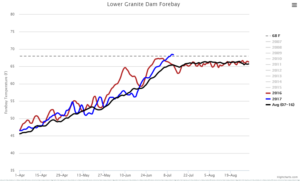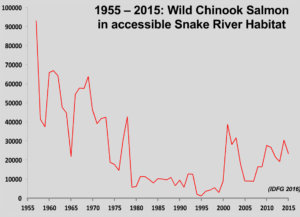Rising temperatures threaten lower Snake River salmon
Posted /Uncategorized
July 2017
July has been a rough month so far for endangered salmon and steelhead migrating through the lower Snake River. High air temperatures and lack of cloud cover have heated the reservoirs behind the four lower Snake River dams to 68 degrees and beyond. At such high water temperatures, the salmon migration slows and it can cause mass mortality (remember 2015?). Water temperatures on July 12th were 3 degrees higher than in 2016 and the 10 year average. And they were equal to 2015.
Dworshak
In the past, Dworshak dam on the Clearwater River has been used to supply cold water that mixes with Snake River water to bring the temperatures down. But that is not entirely possible in 2017. Dworshak can release water in two ways: one is to discharge it through the turbines and the other is to spill it through or over the dam. If water is discharged through the turbines, it does not add considerable dissolved gases to the water. But spilling water does increase the dissolved gas content and it if not monitored, can cause salmon and steelhead mortality. Juvenile fish, like those in the Dworshak National Fish Hatchery just below the dam, are particularly susceptible to Gas Bubble Trauma (GBT). The Nez Perce Tribe and the US Fish and Wildlife Service operate this hatchery.
The Problem
The US Army Corps of Engineers has been working on turbine 3, the largest of the turbines at Dworshak, for many months. Work was supposed to be completed earlier this year. But the contractor doing the work made an error and now the turbine is not expected to be operational until 2018. So this leaves the US Army Corps in a bind. Do they spill water to keep the river cool but poison the juvenile fish at the hatchery? Or limit spill to a certain level and let the river heat up? Total Dissolved Gas (TDG) limits are set by the state to protect fish. A waiver has been issued by Idaho to allow the dam to spill more water and inject higher TDG levels into the river. But thus far these higher levels of spill have not been able to keep the river below 68 F.

The Solution
Endangered Snake River salmon and steelhead are already in dire straits. Their numbers dropped precipitously when the four lower Snake dams were built in the 1960’s and 70’s. This landed them on the Endangered Species List. Billions of dollars have been spent to recover them, but it has not worked. In 2015, hundreds of thousands of adult salmon and steelhead died in the Snake and Columbia Rivers due to heat stress. Over 50% of the juveniles headed to the ocean died that year on their way to the ocean. With so few juveniles making it to the ocean, very few adults are returning this year. There is only one solution to this problem. At the very least, Lower Granite reservoir needs to be drawn down THIS YEAR. And the remaining three dams in subsequent years. Without this urgent action, Snake River salmon and steelhead don’t stand a chance.
